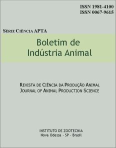Relationship between residual feed intake and daily methane emission in young Nellore bulls
Keywords:
beef cattle, Bos indicus, dry matter intake, feed efficiencyAbstract
The cattle production is a sector of agricultural activity that has impact on global warming due to enteric fermentation from digestive process that releases methane (CH4), with energy loss of food and consequent inefficiency of system. Residual feed intake (RFI) is a feed efficiency trait defined as the difference between actual feed intake and the one predicted on the basis of requirements for body weight production and maintenance. There are evidences that more efficient cattle (low RFI) have lower methane daily emissions than less efficient cattle (high RFI). This study aimed to evaluate the pattern of CH4 daily emission and its relationship with RFI obtained during the CH4 collection in Nelore previously evaluated for this trait. A sample of 23 from 62 young bulls, previously classified into low RFI72 and high RFI72 in the 72-days performance test (RFI72), were evaluated. After the 72-days test, the individual feed intake was recorded for a further 45 days. Another RFI was obtained from the last 32 days (RFI32), and the animals were classified into two RFI32 classes: below zero (low RFI32) and above zero (high RFI32). CH4 daily emissions of each animal were collected during the last 7 days of this period, being preceded by 7 days for adaptation of animals to the collection apparatus. The sulfur hexafluoride (SF6) tracer technique was used for estimating enteric methane emissions. CH4 and SF6 local background were also collected each day from inside of the installation using the same apparatus. The SF6 and CH4 gases were analyzed by gas chromatography. The correlation between RFI72 and RFI32 was not high (0.41) as a 32 days is a short period for accurately measuring the average daily gain. However, the additional period of 32 days is more representative of age, weight and feed intake at the time of CH4 collecting period than 72-days performance test itself. The averages of age, weight and CH4 daily emission were 351±24 days, 343±34 kg, and 155.5 ± 20.2 gCH4/day, respectively. RFI32 class had significant effect (p=0.02) in CH4 daily emission. More efficient animals (low RFI32) emitted almost 12% less CH4 (g/day) than less efficient animals (high RFI32), with average CH4 daily emissions of 144.0±6.1 g/day and 163.0±4.9 g/day. This fact could be explained by the difference (p<0.01) of 12.5% less daily dry matter intake of animals classified as low RFI32 (7.099 ± 0.167 kg/day) from animals classified as high RFI32 (8.120 ± 0.141 kg/day). Although this difference in dry matter intake, there were no differences between the animals of both classes in average daily gain (p=0.73) and metabolic body weight (p=0.61) obtained during the 32 days. These results are consistent with those reported for Bos taurus and indicate the selection of beef cattle based on RFI can be an effective way of reducing the CH4 daily emission without affecting meat production. Thus, the selection of low RFI cattle may contribute to mitigate greenhouse gas emissions from cattle without affecting production. However, studies on genetic parameters for RFI and CH4 daily emission are necessary to strongly recommend the use of RFI in Nelore breeding programs to mitigate greenhouse gas emission.Downloads
Downloads
Published
Issue
Section
License
Os autores não serão remunerados pela publicação de trabalhos, pois devem abrir mão de seus direitos autorais em favor deste periódico. Por outro lado, os autores ficam autorizados a publicar seus artigos, simultaneamente, em repositórios da instituição de sua origem, desde que citada a fonte da publicação original seja Boletim de Indústria Animal. A revista se reserva o direito de efetuar, nos originais, alterações de ordem normativa, ortográfica e gramatical, com vistas a manter o padrão culto da língua e a credibilidade do veículo. Respeitará, no entanto, o estilo de escrever dos autores. Alterações, correções ou sugestões de ordem conceitual serão encaminhadas aos autores, quando necessário. Nesses casos, os artigos, depois de adequados, deverão ser submetidos a nova apreciação. As opiniões emitidas pelos autores dos artigos são de sua exclusiva responsabilidade. Todo o conteúdo deste periódico, exceto onde está identificado, está licenciado sob a Licença Creative Commons Attribution (CC-BY-NC). A condição BY implica que os licenciados podem copiar, distribuir, exibir e executar a obra e fazer trabalhos derivados com base em que só se dão o autor ou licenciante os créditos na forma especificada por estes. A cláusula NC significa que os licenciados podem copiar, distribuir, exibir e executar a obra e fazer trabalhos derivados com base apenas para fins não comerciais.













